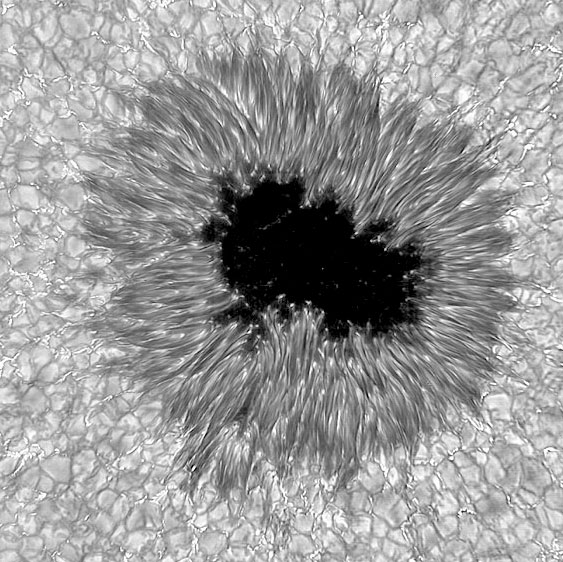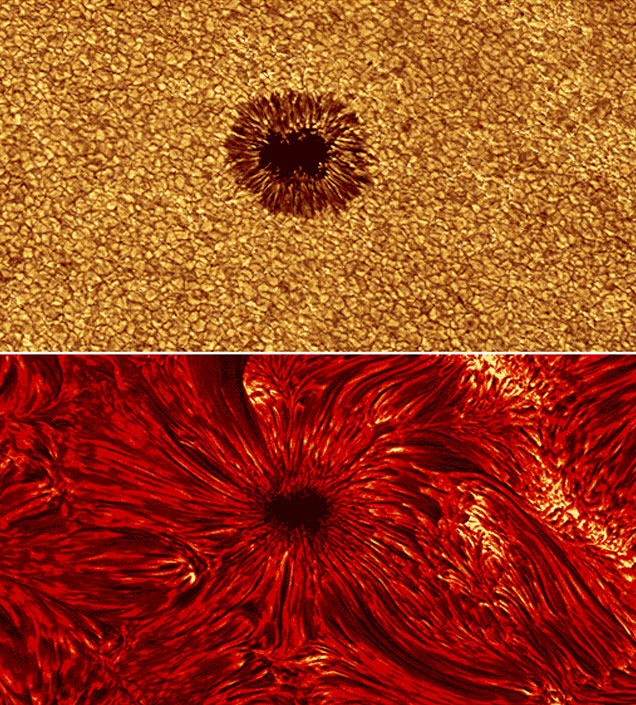|
Electric
Sunspots
Feb 22, 2007
from
Thuntherbolts Website

Credit: Mandatory
credit: Friedrich Woeger, KIS, and Chris Berst and Mark Komsa, NSO/AURA/NSF
Conventional theorists
look to magnetism to solve the problem of solar energy distribution.
If they were to open their eyes to the electrical cause of
magnetism, the solution would suddenly become visible.
This recent image of a sunspot utilized an advance in adaptive
optics that enables ground-based telescopes to detect fine details
that previously only space telescopes could detect.
The announcement of this
technical feat included this conventional theoretical
interpretation:
“The dark cores of
penumbral fibrils and bright penumbral grains are seen as well
in the sunspot penumbra (the fluted structures radiating outward
from the spot). These features hold the key to understanding the
magnetic structure of sunspots and can only be seen in ultra
high-resolution images such as this one. Magnetism in solar
activity is the ‘dark energy problem’ being tackled in solar
physics today.”
The problem is dark to
conventional solar physicists because they shut their eyes to the
fundamental law that magnetism is the result of electric currents.
Seeing the difference between gas (which does not contain free
charged particles and is electrically inactive) and plasma (which
does contain free charged particles and can be electrically very
active) admits the first glimmer of illumination on the problem:
Sunspots are not the result of convection of gas modified by
magnetism. Sunspots are electrical structures.
To understand why penumbral “fibrils” have dark cores, one must see
that they also have a twisted structure that maintains a fairly
constant diameter over great distances. They resemble glowing
tornadoes. This is the structure of a “charge sheath vortex”:
Rapidly rotating charged particles generate strong electric and
magnetic fields. The charged particles are concentrated in a thin
skin, or “double layer”, at the periphery and their motion is
stretched out into a spiral. If the vortex has enough energy to
glow, as it does on the Sun, the edges will appear brighter.
Of course, a sunspot is only a tiny part of the much larger
phenomenon of the Sun. If the spot is electrical, so must be the
entire Sun. Hence to see electricity in any part of the cosmos is to
see that all current astrophysical theories are “in the dark”. The
technical proficiency of space programs and new instruments is
discovering a flood of surprising data about the effects of plasma
in space.
But progress in
understanding this data is vitiated by a theoretical parasitism of
obsolete ideas.
Back to
Contents
Sunspot
Penumbra Shock Astrophysicists
Apr 18, 2006
from
Thuntherbolts Website
Textbook theory of sunspot activity faces new difficulties posed by
the magnetically confined structures of the penumbra. The old idea
that the penumbra filaments are “convection currents” must now give
way to new evidence that electric currents dominate these solar
structures.
We can thank the “Astronomy Picture of the Day” folks for the two
images above. They are from a brief sequence that can be viewed as a
movie by clicking here. The movie shows the sunspot in false-color
images from different heights above the surface or photosphere.
The
first image (upper image in the picture below) shows the Sun's
photosphere as it normally appears, covered with granules.

The large dark sunspot
sports a clear dark umbra in the center through which we can peer
into the cooler region beneath the surface. Surrounding the sunspot
is the lighter penumbra, composed of rope-vortices rising
explosively from beneath the surface. In the linked movie, the
images appearing toward the middle of the sequence show what is
occurring a few hundred kilometers above the photosphere, as the
twisted filaments of the penumbra begin to spread out horizontally.
The last image of the sequence (lower image above) shows the Sun at
a few thousand kilometers into the chromosphere, the layer of the
Sun’s atmosphere just above the photosphere. Here we see the “ropes”
of the sunspot penumbra extending outward into a surrounding maze of
filaments, all constrained by the complex magnetic fields that have
so amazed and enchanted solar physicists in recent years.
For decades, the standard model of the Sun treated the penumbra
filaments as “convection cells”, columns of hot gases transporting
heat from the interior to the surface. Astrophysicists formulated
such concepts while under the spell of gravity and familiar gas
laws. Seeing the Sun as an isolated island in space, they had no
other tools to work with.
But proponents of
the Electric Universe assert that there are no
isolated islands in the universe. They contend that concepts of
simple heat transport are alien to the plasma discharge behavior
evident in sunspot activity. As Wallace Thornhill observed, the
penumbra filaments “bear no resemblance to any known form of
convection in a hot gas, magnetic fields or no”.
So we pose the question: what is controlling the behavior of the
penumbra in these pictures—magnetic fields or gas laws? The new
profile of the solar atmosphere has left the astrophysicists in a
state of ambivalence. The APOD folks do not describe the network of
interacting filaments as “convection cells”.
They say simply,
“Here
magnetic field lines can be clearly followed outward from the
sunspot to distant regions”.
That is not the behavior of convection
cells!
The problem is that now the solar physicists appear to have fallen
under the spell of another popular fiction—that science can
appropriately discuss magnetic fields without concerning itself with
the cause. Now the refrain is,
“Just look at all those twisted
magnetic fields!”
The solar “experts” have
forgotten first principles: only electric currents produce magnetic
fields. Yes, the complex magnetic fields are there, and they are the
predictable effect of “anode tufting” or secondary discharging above
the positively charged sphere in a glow discharge.
While the electric model of the Sun remains to be elaborated in
important details, sunspot activity is eminently suited as a
critical test. Where should one look for evidence of electron
currents flowing into the Sun?
If, as Thornhill claims,
the sunspot is the opening through which discharge currents pass
from the more negatively charged torus around the Sun, then sunspot
activity should be investigated systematically with an entirely new
vantage point in mind.
Back to
Contents
Sunspots Still
Surprise Investigators
Apr 14, 2006
from
Thuntherbolts Website
Anomalous sunspot behavior continues to baffle solar physicists.
Even the cause of sunspots remains elusive, and the more detailed
pictures only seem to push the answers farther down the path.

“Exactly what happens
and why these kind of structures are formed, we don't know “
Dan Kiselman, Royal Swedish Academy of Sciences, Stockholm.
In the extreme close-up
photograph of a sunspot above, we see the rope-like filaments of the
penumbra, or margins of the sunspot.
For many years solar physicists
have claimed that these filaments were convection cells, typical of
heated gases. But the higher-resolution details shown here,
including the twin bridges across the sunspot, do not support
traditional theory. All of the structure shown is consistent with
the principle of anode tufting, a plasma discharge effect expected
of a positively charged electric Sun.
High-resolution images of the penumbra filaments have revealed the
distinctive characteristics of tornado-like charge vortices. By
giving us a peek beneath the tops of the rotating discharge columns,
sunspots enable us to view directly the columns’ explosive rise from
below, as they heat and project plasma upward into the bright
photospheric granules.
For conventional theory,
sunspot penumbrae remain a mystery: the standard solar model neither
requires nor predicts such phenomena. In the electric model they are
predictable. Electric discharges in plasma take the form of long,
thin and twisting filaments. Because they are tornadic funnels of
glowing plasma, they will appear darker in their centers, exactly as
seen in the recent pictures. Convection cells would appear darker on
their cooler peripheries.
The electric explanation of sunspots, like that of the penumbra, is
rooted in the observed behavior of plasma discharge. In laboratory
experiments, a torus forms above the equator of a positively charged
sphere. Discharges then fly between the torus and the mid- to
low-latitudes of the sphere. In the electric model, the Sun is the
positively charged focal point of an electric field. And now we know
that the Sun is indeed surrounded by an equatorial torus (as shown
in the polar UV image here).
Sunspots are the direct
evidence that electric discharges punch holes in the photosphere to
deliver current directly to lower depths, exposing a view of the
cooler interior. Nothing ever observed on the Sun supports the idea
of heat transfer from the core, where standard theory places the
nuclear fusion “furnace”. In the electric model, what nuclear fusion
that does occur is located where the most energetic events occur, in
the fierce electric tornadoes.
In the laboratory experiments that produce the equatorial torus, the
observed discharging to the positively charged sphere migrates
latitudinally as the power input varies. The higher power produces
maximum activity near the equator. The same thing occurs on the Sun
in the latitudinal migration of sunspots in relation to the total
energetic output of the Sun.
Standard theory will not allow that the cooler lower region revealed
by sunspots means a cooler interior of the Sun. So astrophysicists
have surmised that the sunspots are the result of focused magnetic
fields interfering with heat transport, or convection. But they have
confused electrical and magnetic effects. Investigation has shown
that sunspots having the same magnetic polarity attract each other.
But the poles of magnets repel.
Electric currents,
however (the source of magnetic fields), do attract each other,
while maintaining their integrity through repulsion at extremely
close distances. In fact, we see this effect when sunspots “merge”.
Though conjoined, they retain their independent structure, just as
currents do in plasma.
Standard models offer no coherent explanation for the approximate
eleven-year sunspot cycle. There is no annual "clock" in an isolated
thermonuclear explosion. Though a connection to the period of
Jupiter is possible, perhaps even likely in terms of solar system
circuitry, the remote gravitational effects of Jupiter on the Sun
cannot compare to the energetic events associated with the sunspot
cycle.
In the electrical model
the sunspot cycle is most likely a result a fluctuations in the
electrical power supply from the local arm of our galaxy, the Milky
Way, as the varying current density and magnetic fields of huge
Birkeland current filaments slowly rotate past our solar system.
(See:
Sunspot Mysteries)
Back to
Contents
Sunspots and
Earthquakes
Apr 04, 2006
from
Thuntherbolts Website
Civilization's interest in predicting the location and time of
damaging earthquakes is obvious. The potential for devastation of
property that otherwise could be secured, and the loss of life that
otherwise could be prevented, are powerful reasons to find
predictive factors.
Some scientists have become aware of a correlation between sunspots
and Earthquakes and want to use the sunspot data to help predict
earthquakes. The theory is that an intensification of the magnetic
field can cause changes in the geo-sphere. The NASA and the European
Geosciences Union have already put their stamp of approval on the
sunspot hypothesis, which suggests that changes in the sun-earth
environment affects the magnetic field of the earth that can trigger
earthquakes in areas prone to it.
It is not clear how such a trigger
might work.

In the Journal of Scientific Exploration, Vol. 17, No. 1, pp. 37–71,
2003, there is an excellent report that addresses the more
down-to-earth problems facing geophysicists trying to understand
earthquakes. The paper is titled, Rocks That Crackle and Sparkle and
Glow: Strange Pre-Earthquake Phenomena, by Dr. Friedemann T. Freund,
a professor in the Department of Physics, San Jose State University,
and a senior researcher at NASA Ames Research Center.
Dr. Freund writes,
"Many strange
phenomena precede large earthquakes. Some of them have been
reported for centuries, even millennia. The list is long and
diverse: bulging of the Earth’s surface, changing well water
levels, ground-hugging fog, low frequency electromagnetic
emission, earthquake lights from ridges and mountain tops,
magnetic field anomalies up to 0.5% of the Earth’s dipole field,
temperature anomalies by several degrees over wide areas as seen
in satellite images, changes in the plasma density of the
ionosphere, and strange animal behavior.
Because it seems
nearly impossible to imagine that such diverse phenomena could
have a common physical cause, there is great confusion and even
greater controversy."
Freund outlines the
basic problem,
"Based on the
reported laboratory results of electrical measurements, no
mechanism seemed to exist that could account for the generation
of those large currents in the Earth’s crust, which are needed
to explain the strong EM signals and magnetic anomalies that
have been documented before some earthquakes.
Unfortunately, when
a set of observations cannot be explained within the framework
of existing knowledge, the tendency is not to believe the
observation. Therefore, a general malaise has taken root in the
geophysical community when it comes to the many reported
non-seismic and non-geodesic pre-earthquake phenomena… There
seems to be no bona fide physical process by which electric
currents of sufficient magnitude could be generated in crustal
rocks."
Freund makes an
excellent attempt to explain all of the phenomena in terms of rock
acting like a p-type semi-conducting material when placed under
stress. For example, the emission of positive ions from the Earth’s
surface may act as nuclei for the ground-hugging fog that sometimes
occur prior to earthquake activity. And although the surface
potential may only be in the 1–2-Volt range, the associated electric
field can reach hundreds of thousands of Volts per centimeter,
enough to cause corona discharges, or "earthquake lights."
Thermal anomalies seen
from space before an earthquake may be due to the emission of
infra-red light where the semi-conductor charge recombines at the
surface. Disturbed animal behavior may be due to the presence of
positive ions in the air.
As Freund says, this theory places an explanation in the realm of
semiconductor physics, which means that geoscientists are not the
best people to judge it. That explains why the paper appears in a
speculative journal.
Freund laments,
"the peer review
system often creates near-insurmountable hurdles against the
publication of data that seem contrary to long-held beliefs."
Freund has identified a
source of charge in stressed rocks that was not believed possible.
He says,
"…once fully told
and understood, the "story" [of p-holes] is basically so simple
that many mainstream geoscientists are left to wonder why it has
taken so long for them to be discovered. If they are so
ubiquitous as they appear to be, why did p-holes go unnoticed
for over a hundred years? Confronted with this question, by a
twist of logic, many 'mainstreamers' succumb to the impulse to
reject the p-hole concept out of hand.
The difficulties encountered in the connection with p-holes are
similar to others that have punctuated the history of science.
The discovery of the p-holes as dormant yet powerful charge
carriers in the Earth’s crust calls for a new paradigm in
earthquake research and beyond. More often than not, any call
for a new paradigm elicits opposition. Therefore, I close with a
quote from the philosopher Arthur Schopenhauer, who ventured to
say: 'all truth passes through three stages. First, it is
ridiculed. Second, it is violently opposed. Third, it is
accepted as being self-evident'."
If Freund has a problem
getting such a simple idea accepted, how much more difficult is it
going to be to get both astronomers and geoscientists to accept that
the Earth is a charged body in an Electric Universe?
The missing link between the sunspots and earthquakes is the fact
that the electric discharges on the Sun that cause sunspots also
affect the Earth's ionosphere. The ionosphere forms one "plate" of a
capacitor, while the Earth forms the other. Changes of voltage on
one plate will induce movement of charge on the other. But unlike a
capacitor, the Earth has charge distributed beneath the surface.
And if the subsurface
rock has become semi-conducting because of stress, there is an
opportunity for sudden electrical breakdown to occur through that
rock. The mystery of how the current is generated is solved and the
link with sunspots exposed. Subsurface lightning causes earthquakes!
Seismic waves are the equivalent of the rumble of thunder. The
energy released may be equivalent to the detonation of many atomic
bombs but only a small proportion needs to come from the release of
strain in the rocks. Most of it comes from the Earth's stored
internal electrical energy.
The latest issue of the IEEE journal, SPECTRUM, features an article
based on Freund's work that looks at ways of predicting earthquakes.
Once again, it seems that scientific advances fare better today in
the hands of electrical engineers. (See
Earthquake Alarm)
Back to
Contents
|



